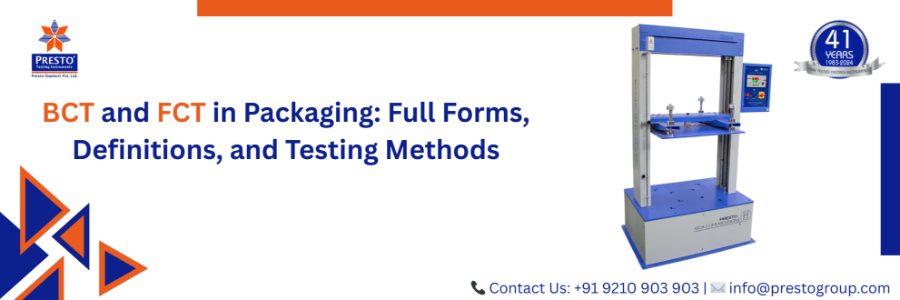

Corrugated boxes are everywhere—think of the packages that deliver your online orders or store goods in warehouses. These boxes need to be tough enough to handle stacking, shipping, and rough handling without crushing or damaging what’s inside. That’s where Box Compression Test (BCT) and Flat Crush Test (FCT) come in. These tests check if a box or its material can take the pressure. In this blog, we’ll explain what BCT and FCT stand for, how they work, the machines used to test them, and what it costs to run these tests. We’ve also added a handy comparison table and answers to common questions to make it all clear.
BCT Full Form: Box Compression Test
The Box Compression Test (BCT) checks how much weight a whole corrugated box can handle before it buckles or collapses. Picture a stack of boxes in a truck or warehouse—BCT mimics that pressure to see if the box can hold up. The result, called the BCT value, is measured in Newtons (N) or pounds (lb) and shows the maximum load the box can take. This ensures your products stay safe during shipping or storage.
FCT Full Form: Flat Crush Test
The Flat Crush Test (FCT) looks at the corrugated board itself, not the whole box. It tests the wavy middle layer (called flutes) to see how much pressure it can take before getting crushed. FCT is measured in kilopascals (kPa) or pounds per square inch (PSI). This test matters because strong flutes keep the box’s shape intact, even when it’s under stress.
Both tests help box makers ensure their packaging is strong enough for the job without using more material than needed.
Corrugated boxes carry everything from TVs to canned goods, but they face tough conditions: heavy stacking, bumpy roads, or rough handling. A weak box can crush, ruin products, upset customers, and cost money. BCT and FCT make sure boxes are up to the task. Here’s why they’re important:
To make it easier to understand how BCT and FCT differ, here’s a table breaking down the key points:
| Feature | Box Compression Test (BCT) | Flat Crush Test (FCT) |
| What It Tests | Strength of a complete corrugated box | Strength of corrugated board’s flutes |
| Purpose | Checks if a box can handle stacking pressure | Tests if the board’s flutes resist crushing |
| Measurement | Newtons (N) or pounds (lb) | Kilopascals (kPa) or PSI |
| Equipment | Box Compression Tester | Flat Crush Strength Tester |
| Standards | ASTM D642, ISO 12048, TAPPI T804 | ISO 3035, TAPPI T825, FEFCO No. 6 |
| Use Case | Ensures boxes stack safely in shipping/storage | Helps pick the right board for box strength |
This table shows how BCT and FCT work together to ensure boxes are both strong and made from the right materials.
Testing Steps
The BCT uses a box compression tester, a machine that presses down on a box to test its strength. Here’s how it’s done:
A few things can change how a box performs in the test:
BCT helps:
Testing Steps
The FCT uses a flat crush strength tester, often a modified edge crush tester with flat plates. It tests a small piece of corrugated board. Here’s the process:
Flute Type: Flutes come in different shapes (like A, B, or C), and each has different crush resistance.
FCT is useful for:
A box compression tester is a heavy-duty machine that mimics the weight boxes face when stacked. Features include:
Brands like Presto, Testronix, or Pacorr make testers for small cartons or big pallets, with capacities from 500 KGF to over 1000 KN.
The flat crush strength tester is smaller and tests board samples. It often doubles as an edge crush tester with flat plates. Features include:
These testers are common in quality control labs to check materials before making boxes.
To get reliable results:
1. What’s the difference between BCT and FCT?
BCT tests the strength of a whole corrugated box to see how much weight it can handle before collapsing. FCT tests just the corrugated board, checking how well the flutes resist crushing. BCT is about the finished box; FCT is about the material.
2. Why does moisture affect BCT and FCT results?
Moisture weakens corrugated boxes and boards, making them less able to handle pressure. Testing in a controlled environment (like 23°C and 50% humidity) ensures results reflect real-world performance.
3. What standards should I follow for BCT and FCT?
For BCT, use standards like ASTM D642, ISO 12048, or TAPPI T804 to test box strength. For FCT, follow ISO 3035, TAPPI T825, or FEFCO No. 6 to check flute strength.
The Box Compression Test (BCT) and Flat Crush Test (FCT) are key to making sure corrugated boxes can handle the demands of shipping and storage. By testing the box’s strength and the board’s flutes, these tests help create packaging that’s tough, cost-effective, and eco-friendly. Using reliable machines like box compression testers and flat crush strength testers, following standards, and keeping costs in check ensures your boxes do their job. The comparison table and FAQs above should help you understand and apply these tests to make better packaging decisions.
Connect with us for your business enquiries. Generally, we respond within one or two working days.